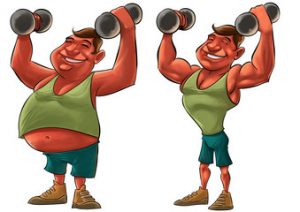Most people think of weightlifting as a way to build muscle, but did you know that you can also use weightlifting to burn fat? In fact, weightlifting is an excellent way to boost your metabolism and torch calories. If you’re looking to lose weight, adding weightlifting to your routine can help you get there faster. So, if you’re wondering how weightlifting can help you burn fat, keep reading. We’ll explore some of the benefits of this type of exercise and show you how to incorporate it into your routine.
How Lifting Weights Burns Fat
Let’s start with how lifting weights can help you get leaner and more cut.
Body fat accumulates as a result of not burning enough calories consistently. In a nutshell, you’re not exercising, aren’t doing enough activity, or possibly overeating. That’s all there is to it, for the most part.
Lifting weights requires more energy expenditure, so you’ll burn more calories. And I’ll show you how to make your workouts more intense so that you expend more energy.
Second, having lean muscle tissue allows your body to burn fat more effectively. In fact, research has shown that muscle tissue burns more calories than body fat, even when resting. Roughly, 10 pounds of muscle burns 50 calories per day at rest, whereas 10 pounds of fat burns 20 calories.
On the other hand, lifting weights builds muscle far better than any other exercise.
I’ll now show you five ways to improve the effectiveness of your workouts. These methods will help you burn fat and build more muscle tissue.
1 – Perform Slower Reps
One key that helps weightlifting to burn fat is maintaining a longer time under tension. This is one of the best ways to expend more energy during workouts. Simply slowing down your rep speed will accomplish this. This is the technique that allows weightlifting to burn fat consistently.
How do slower reps help you burn more fat?
Surprisingly, this technique aids in muscle development. This is more noticeable during the negative portion of the rep when the muscle is under more stress.
It’s a win-win situation. You’re increasing your activity level and energy expenditure, which results in more calorie burn. You are also gaining muscle mass.
Remember what we said earlier: more lean muscle converts your body into a fat-burning machine.
The following is an example of a leg workout with slower reps:
- Deadlifts (stiff-legs): 4 sets of 12 reps. On the last two reps of each set, spend 4-5 seconds on the negative.
- Leg Press: 4 sets of 12 reps each. Take 3-4 seconds on the descent for the first six reps, then pump out the remaining six.
- Squats: 4 sets of 10 reps each. On the last two reps of each set, spend 4-5 seconds on the negative.
- Leg Extensions: 4 sets of 15 reps each. Take 3-4 seconds on the descent for the first ten reps, then pump out the remaining five reps.
- Lying Leg Curls: three sets of eight reps. All reps should take 3-4 seconds to descend.
After trying this, your legs will be pumped. Of course, you can apply this concept to other parts of your body as well.
2 – Take shorter breaks between sets.

Another way to increase the energy expenditure of your workouts is to reduce your rest time between sets.
Remember that your goal is to build or maintain lean muscle. As a result, you don’t want to reduce your rest between sets to the point where you sacrifice strength.
Here’s an illustration using a chest workout:
- Pec Dec Flyes: 4 sets x 12 reps
30-second rest between sets - Bench Press: 4 sets x 8 reps
2-minute rest between sets - Hammer Strength Chest Press: 4 sets x 10 reps
45-second rest between sets - Incline Dumbbell Press: 4 sets x 10 reps
1-minute rest between sets
You’re maintaining your strength at the start of your workout by focusing on compound exercises. Then, you begin to reduce your rest between sets for each subsequent exercise.
This is the ideal fat-burning, muscle-building workout.
3 – Increase Your Training Frequency
Lifting weights for longer periods is the simplest way to burn more calories. The good news is that you don’t need to go crazy or significantly increase your workout time.
Try adding just ten minutes to your current workout routine. Here are some suggestions.
- Finish your workout with an additional isolation exercise.
- Perform an additional set of each exercise.
- Before you begin your actual workout, pre-exhaust your muscles.
- On the final set of each exercise, incorporate a technique such as drop sets, supersets, or rest-pause sets.
- Perform some core work in between each set.
These are some straightforward methods for increasing your training volume. It’s also an easy way to burn more calories during your workouts.
4 – Train Opposite Muscle Groups
Have you ever worked out opposing muscles at the same time? Train your agonist and antagonist muscles together to increase your energy expenditure.
Following are some examples:
- Back and Chest
- Shoulders on the Back
- Triceps and Biceps
- Quadriceps and Hamstrings
Of course, you may already train your arms and legs in this manner. However, there is one other method that you should try.
Instead of doing all biceps and then triceps, do a bicep exercise and then a tricep exercise. This isn’t quite a superset, but you’ll be resting less between sets.
Another example is training the back and chest at the same time. If you do a back exercise, you won’t need to rest as much because you’ll be doing a chest exercise, which works the opposite muscle.
Why does training opposing muscles together work so well for fat loss and muscle building?
Training opposing muscles at the same time will improve your conditioning. You’ve nearly doubled your workload.
An example of a back and chest workout is as follows:
- 8 reps: Barbell rows
- 8 reps: Incline bench press
Repeat this circuit three times more.
- 10 reps: Seated rows
- 10 reps: Dumbbell press
Repeat this circuit three times more.
12 reps: Lat pulldowns
- 12 reps: Cable flyes
Repeat this circuit three times more.
5 – Increase the Frequency of Your Workouts
Finally, try increasing the frequency of your workouts. There are several approaches you can take.
- On certain weeks, add an extra workout day.
- Set aside some days for twice-daily training (ex: morning and evening workouts)
- Instead of once a week, train each or some muscles twice a week.
- To broaden your workouts, divide your muscles into larger and smaller groups.
You don’t want to train the same muscle twice in a row. Make sure that the muscle has at least 2-3 days of rest in between workouts.
Here are some ideas for structuring your workouts to increase your training frequency:
- Monday: Chest and triceps
- Tuesday: Legs
- Wednesday: Back and biceps
- Thursday: Shoulders
- Friday: Light chest
- Saturday: Light back and legs
- Sunday: Rest
The idea is to increase your level of activity. This does not have to be limited to weight training.
You could, for example, lift weights in the morning and do cardio in the evening. Another option is to practice yoga or deep stretching. Anything that keeps your body moving will help you burn more calories.
Weightlifting to Get Lean and Shredded

As I mentioned at the outset, cardio has a place in burning calories and getting lean. Many people, however, make the mistake of increasing their cardio, which increases the risk of burning into muscle.
Remember: Don’t overdo cardio while ‘underdoing’ lifting weights.
Nutrition is another prominent topic not covered in this article. You can train all you want, but you won’t get the results if you don’t eat well or overeat. For guidelines on how to maintain a health diet see 5 Healthy Eating Choices.
I hope this post inspires you to hit the gym and work harder. The bottom line is you get out of your exercising what you put in. And using weighting to burn fat and tone your body is an excellent start.

